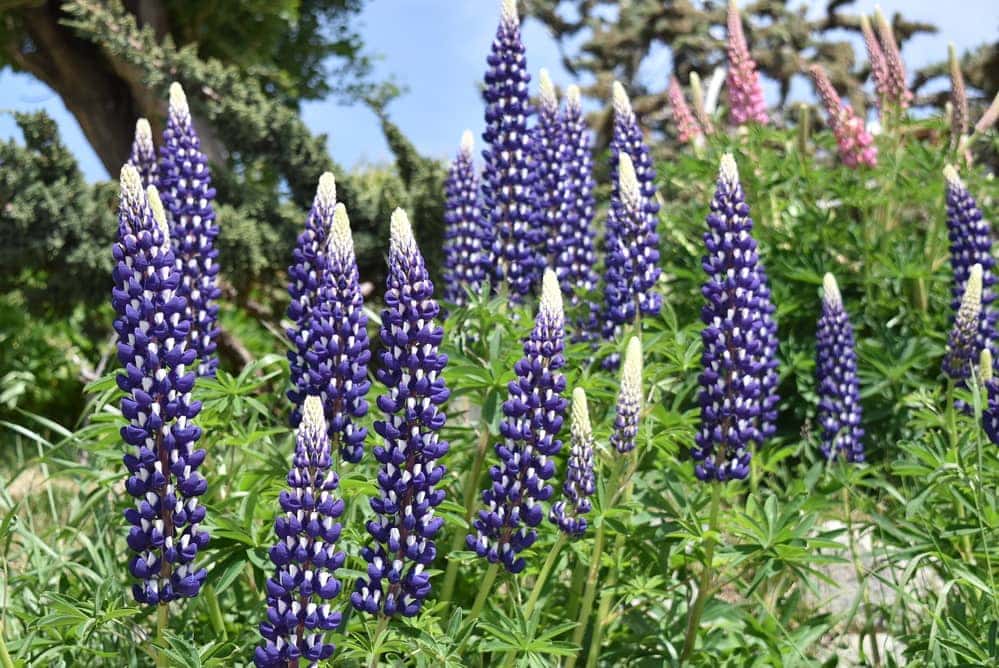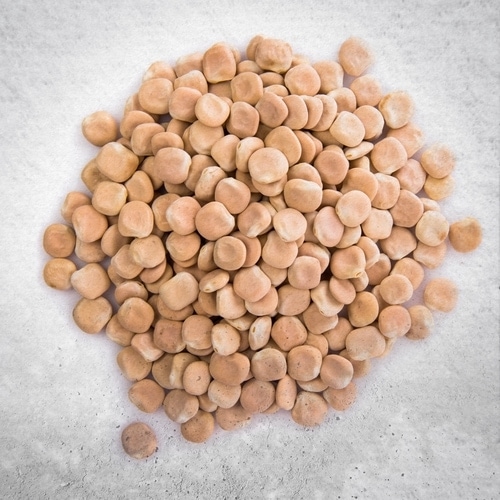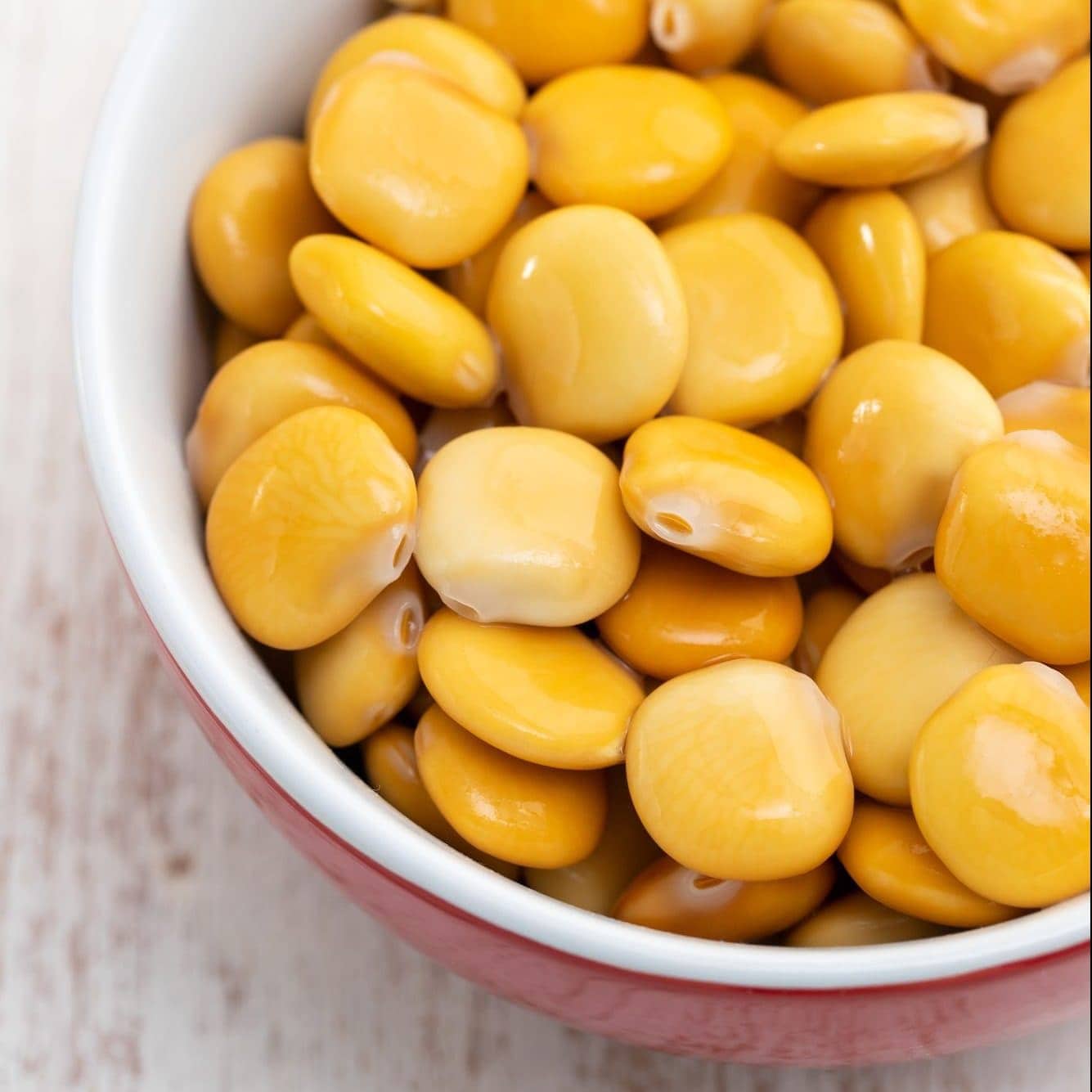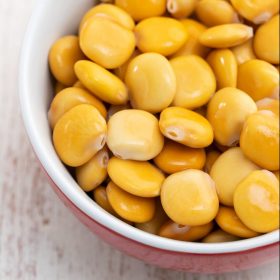Lupini beans are the seeds of the Lupinus albus, a plant belonging to the Leguminous family. It grows up to one meter tall and has palmate leaves. This legume has been widely known and used since ancient times in the Mediterranean basin and the Middle East.

In times of famine, children would go around with their pockets full of lupini beans to eat, leaving a trail of peels. Today, it is more than a food. We find this peculiar legume as a pastime at village festivals and fairs in Italy, where they are sold in stalls.
This legume has been cultivated for different purposes throughout the centuries. Some are to improve the soil for grazing, as a nutritious food and for its therapeutic properties. Archaeologists have found these seeds in the Egyptian and Mayan pyramids. The first crops can be traced back to about 4000 years ago, both in the Mediterranean and in the Andean region of South America.
Lupins are composed of 10% water, 40% carbohydrates, 38% proteins and 3.2% ashes, with the remaining percentage made up of fats.

Dried lupins
They contain zinc, which promotes immune function. Manganese, which neutralizes free radicals and prevents cell damage. Copper, selenium, magnesium, help keeping bone density perfect and protects muscle support. Other nutrients are calcium, phosphorus, potassium, sodium and iron, as well as vitamin A, B vitamins and vitamin C.
The presence of amino acids such as glutamic acid and aspartic acid is also very high. Lupines contain arginine, beneficial on endothelial function, improving the performance of blood vessels. Thiamin (vitamin B1), essential for the metabolism of carbohydrates and fats, helping to keep the nervous system healthy. And lastly, folic acid (vitamin B9), which helps the body to metabolize proteins and controls the activity of genes.
These legumes are an excellent alternative to animal proteins, providing a remarkable contribution. In fact, the proteins present in them are 38 gr. to every 100 gr. of protein, a quantity comparable to that of meat and superior to that of eggs.
They are easy to digest, prevent hypertension, reduce the levels of bad cholesterol and increase the good one thanks to their omega 3s. They contain tocopherol, which helps to prevent type 2 diabetes and colon cancer. And also the protein conglutin, found in the seeds, that helps to fight the accumulation of glucose in the blood, mimicking the action of insulin.
Their fibers exert also an essential function. It accelerates the intestinal transit, contrast constipation, give a sense of satiety. They are helping in weight loss in a low-calorie and balanced diet.
Lupini beans are gluten-free. The flour is used in the preparation of bread, pasta, biscuits, and crackers for those with a gluten intolerance. Other uses are in sausages and canned meat.

Lupini beans contain 116 kcal per 100 gr. of product. They contain two basic alkaloid substances, the lupaina and the lupine, that are very bitter and toxic if ingested in high quantities. For this reason, in order to eliminate them, they need to be soaked for 3-4 days and then boiled for 20 minutes. (Lupinus in Greek means “bitter taste”).

You can enjoy this tasty snack as is, or salted like they do in Italy.
Lupini beans are a classic for Christmas! Thank you they remind me of my traditions! Buon Natale!
Here in Ecuador, lupini beans are called ‘chochos’ and are most often marinated in lime juice and topped with crumbled plantain chips and toasted corn. Sometimes the chochos are made into a cold vegetarian ceviche in a base of tomato sauce with sliced onion and topped with the plantain chips and toasted corn. This is called ‘cevichocho’ and you can buy it from street vendors. It is so delicious.
Muchas gracias Maia! This is absolutely interesting and I would love to try cevichocho, hopefully I can visit Ecuador soon!
Hi Maia, I spent a semester studying in Ecuador several years ago. I miss Quito sooo much!! I love cevichocho too! I’m trying to make it now. I have a ceviche recipe that I usually use with shrimp, but I’d love your cevichocho recipe if you’d be willing to share. :)
Can you share recipe on how to make the brine for traditional chochos.
Is there any recipes with lupini beans and noodles? I bought a little bucket from an Italian grocer and a woman told me that they would be delicious with noodles and garlic but I can’t find a recipe for such a thing.
Hi Theresa – I am afraid but I don’t think there’s such a pasta dish with lupini. They are mostly used as an appetizer or in salads. But I might be wrong…
Do they need to be refrigerated while they soak for 5 days after they are boiled?
Hi Sara – No, you can soak them at room temperature.
Once processed/brined, can the beans be eaten with their skins, or do they have to have those removed first?
Although the skin can be eaten, I wouldn’t recommend it. Usually people remove the skin with the front teeth by opening it a bit while pressing the bean between you fingers. This will push the bean out of the skin directly to your mouth.
In the cooking directions #4 it reads …………………………………. Once the water boils, cook for about 2 hours, 2½ hours and, halfway through cooking, transfer the lupini to the other pot.
Does that mean to transfer into other pot after 1 hour of cooking?
Thanks so much. I remember as a very young girl my Noni’s lupini bean soaking in the pump house at the ranch and I’m so excited to carry on the traction.
Hi Carol – yes, correct. Thank you for stopping by and Buona Pasqua!
After you boil them in the brine for one minute what do you do next? Do you leave to cool in the pot before transferring to a jar or bowl and place it in the fridge or do you wait until it reaches room temperature before placing in fridge? NB I’m transferring into jars to gift to my mum who loves lupini.
Hi Sue – you can leave them to cool in the pot.
Hola, soy fanático de los lupines. los preparo sin cocción, solo con salmuera generando una fermentación (como el chucrut). Demora cerca de dos meses , depende de la temperatura ambiente, para perder el amargo. Pero contienen muchos probióticos como el yogur. Paciencia para cambiar la salmuera cada 10 días y empezar otra tanda a la mitad del proceso para no quedarse sin esta delicia.
Hola Gerardo, fantastico! Muchas gracias por tu aportación, voy a seguir tu metodo la proxima vez que les voy a preparar.
What if they are still bitter after soaking and brining? I don’t particularly mind but are they at least safe to eat? I guess next time I’ll be sure to change the soaking water more than 2x per day…
Hi Michelle – They should be ok, they are a bit bitter normally. You can try to leave them in the water a bit more before enjoying them.
Hi, I just made these; we call them tremocos in Portuguese and they were so easy and taste just like they did when I was a child, amazing. Thank you for your help; I’m on to my second batch.
Fantastico! I am glad you liked them! I also was eating them when I was a child, beautiful memories. Muito obrigado for stopping by!
Mine are ready to put in jars. Do I have to refrigerate them after I put them in jars?
Hi Fred – They should be stored in a brine. To prepare the brine: in a medium pot bring 1.5L of water to boil, add 90 grams of salt. When the water boils, add the lupini beans slowly to the pot. Let the water with the lupini beans slowly boil again for 3 minutes. After 3 minutes, turn off the burner and add the lupini beans into the jars. The brine should cover the lupini beans completely, leave one inch aprox between the top of the jar and the lupini beans. Repeat this for every jar, if the water cools down, turn the water back up and slowly boil it again, since the lupini beans should be jarred while hot. Leave the jars to cool down and store them in the pantry.
Thanks for the question, I’ll update the article as well.
Thank you for the wonderful recipe for Lupini Beans. My husband adores them, and goes through one of those tiny jars of prepared beans in about a second. I bought a big bag of the dried beans for about the price of one jar, and have been preparing them like this since then. He can now eat his fill of the beans and we aren’t broke. And yes, he eats the skins, too. I appreciate your sharing your Nonna’s recipe – I am not Italian (oh! – the scandal) and would never have come to this method by myself, so this is doubly appreciated.
Ciao Kathy – That’s amazing!! Thank you for sharing your story, I am really glad that the recipe has been helpful!!
I have a question. Instead of using so much salt, can you substitute vinegar to help preserve the lupini?
Ciao Pasquale – I am afraid not, salt is the key ingredient for brining, which has the function to kill all the microorganisms in the lupini and so facilitate its preservation. You can wash the lupini with running water right before consuming them if you are concerned about the salt taste.
Just finished making these. They turned out so good and I felt my grandfather with me the whole time I rinsed them each day.
When I was young, we had these each Christmas. For years I wondered how to make them and wished I had asked my grandparents before they passed.
This recipe states much like theirs and thank you very much!
Ahhh that makes me so happy Diana! I am glad that they turned out great, I am actually going to buy them today as I am craving them too. Grazie mille!!
I am just finishing my first batch and have a question regarding storing the lupini in the pantry once jarred. How long will they last on e jarred? Grazie
Ciao Matteo, they can last up to 4-6 months in a vacuum sealed jar entirely covered with its brine. If the vacuum seal is not present, store them for up to 2 months in the fridge.
It’s the first I’ve ever tried lupin beans , turned out to be delicious ,is it possible lupin bean can be cooked with meat
Fantastic! I have never heard of a recipe that uses lupini with meat, in Italy we usually eat them snacking at the table, maybe in other countries?
I have only becomes familiar with lupini beans recently and after reading your excellent instructions am anxious to try them. This maybe sacrilegious but is it possible to use a pressure cooker to shorten the process? I look forward to your reply. Thank you!
Ciao Kendal, great question! Yes, you can cook them in the pressure cooker for about 1-1.15 hours.
When I was a kid I remember my mother would fill a pillowcase with Tremocos and brine them for days in a large sink until they were ‘sweet’ .
Great memories…
Ciao Mel – Grazie for sharing your memories!